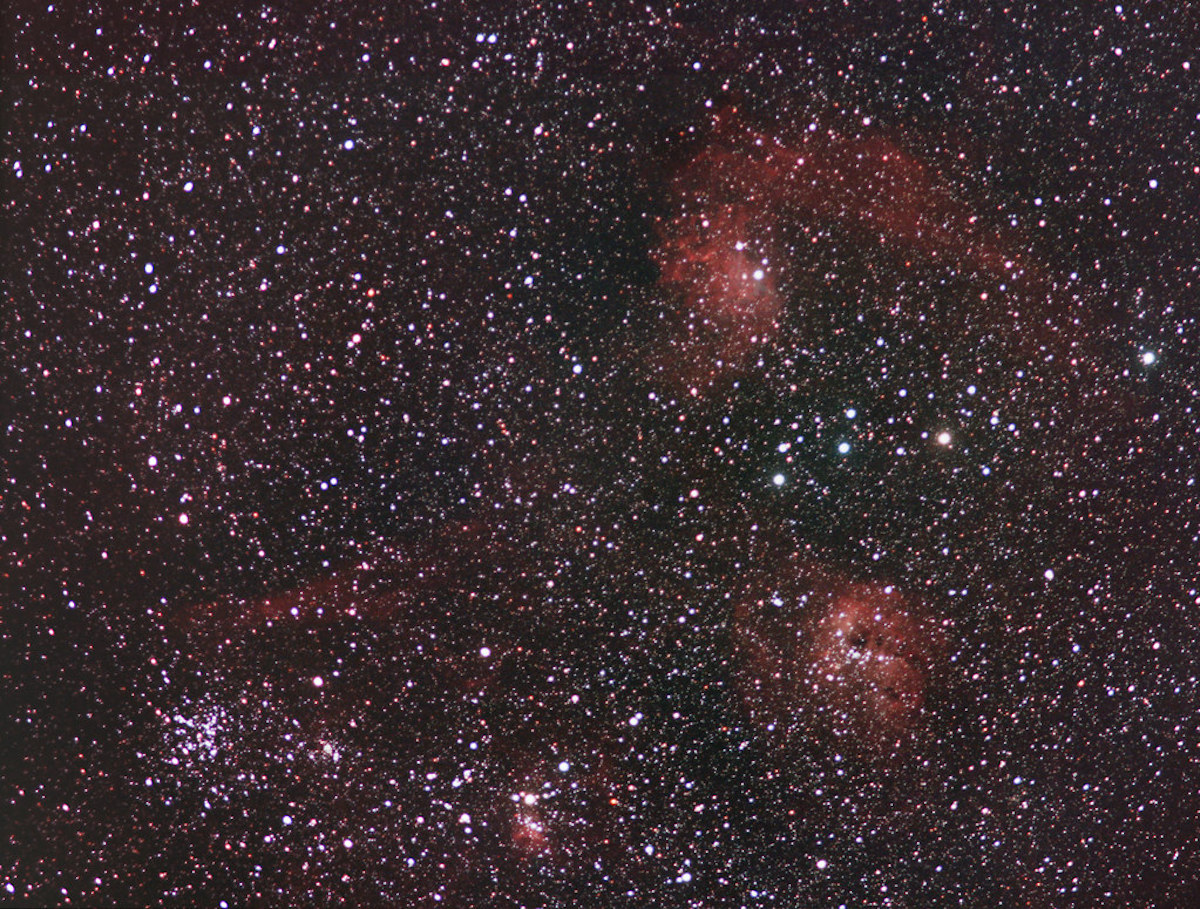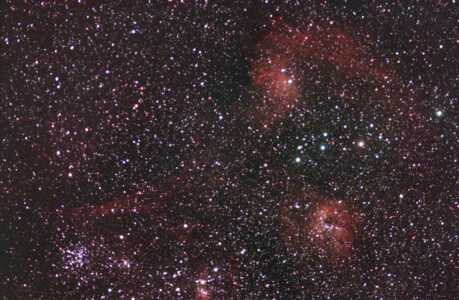Stargazing is a mesmerizing experience that brings us closer to the mysteries of the universe. The Irish skies are home to many wonders, including the constellation Auriga, which is easily recognizable and visible from most parts of the country. In this article, we will take a closer look at this beautiful constellation, its mythology and history, and provide tips for observing it from Ireland.
What is Auriga?
Auriga is a prominent constellation in the northern hemisphere, located between the constellations Taurus, Gemini, Lynx, and Perseus. Its name means “the Charioteer” in Latin, and it is often depicted as a charioteer holding a whip in one hand and reins in the other. The constellation is home to several bright stars, including Capella, which is the sixth brightest star in the sky and the most prominent member of the Auriga constellation.
Mythology and History of Auriga:
In Greek mythology, Auriga is associated with several legends, including that of King Oenomaus and his charioteer Myrtilus. According to the myth, Myrtilus helped Oenomaus win several chariot races by sabotaging the chariots of his opponents. However, when Oenomaus found out, he killed Myrtilus, who cursed him and his descendants before he died. In another myth, Auriga is associated with the god Hermes, who used a chariot to travel between the realms of the gods and the mortals.
Auriga has been recognized since ancient times, and its stars have been used for navigation and timekeeping. In the 17th century, Johannes Hevelius named and mapped the constellation, and it has been a part of modern astronomy ever since.
Observing Auriga from Ireland:
Auriga is visible from Ireland throughout the winter months, from November to March. The best time to observe it is during the early evening hours, when it is highest in the sky. You can locate Auriga by finding the bright star Capella, which is located in the constellation’s center. Capella is a yellow-giant star that is visible to the naked eye, and it is easy to spot even in light-polluted areas.
Auriga is a large constellation that is best viewed using binoculars or a telescope. Through a telescope, you can see its bright stars and deep-sky objects, such as the open cluster M38 and the emission nebula IC 405.
When observing Auriga, it’s important to find a location with minimal light pollution. Some of the best locations for stargazing in Ireland include the Dark Sky Reserve in Kerry, the Burren National Park in Clare, and the Mayo Dark Sky Park.
Auriga is a beautiful and easy-to-spot constellation that is visible from most parts of Ireland during the winter months. Its bright star Capella and the rich mythology and history associated with it make it a captivating sight for stargazers of all levels. By following our tips for observing Auriga and finding the right location, you can experience the majesty of this celestial wonder for yourself.
How can I see the constellation of Auriga from Ireland?
The constellation of Auriga is visible from Ireland during the winter months, from November to March. To see Auriga, you should start by finding a location with minimal light pollution. Some of the best locations for stargazing in Ireland include the Dark Sky Reserve in Kerry, the Burren National Park in Clare, and the Mayo Dark Sky Park.
Once you’ve found a suitable location, look towards the northeastern sky after sunset. You should be able to spot the bright star Capella, which is the most prominent member of the Auriga constellation. Capella is a yellow-giant star that is visible to the naked eye, and it is easy to spot even in light-polluted areas.
Auriga is a large constellation that is best viewed using binoculars or a telescope. Through a telescope, you can see its bright stars and deep-sky objects, such as the open cluster M38 and the emission nebula IC 405.
When observing Auriga, it’s important to dress warmly and bring along a red flashlight to preserve your night vision. Also, be patient and take your time to observe the constellation, as it may take a few minutes for your eyes to adjust to the darkness.
In summary, to see the constellation of Auriga from Ireland, find a location with minimal light pollution, look towards the northeastern sky after sunset, and use binoculars or a telescope to observe its bright stars and deep-sky objects. Remember to dress warmly, bring a red flashlight, and be patient when observing the constellation.
The mythology of the constellation of Auriga
The constellation of Auriga, also known as the Charioteer, has a rich mythology that dates back to ancient Greece. In Greek mythology, Auriga is associated with several legends, including the stories of the king Oenomaus and the god Hermes.
According to one myth, Auriga represents the charioteer Myrtilus, who served the king Oenomaus. Myrtilus helped Oenomaus win several chariot races by sabotaging the chariots of his opponents. However, when Oenomaus found out, he killed Myrtilus, who cursed him and his descendants before he died.
Another myth associates Auriga with the god Hermes, who is often depicted wearing a winged hat and carrying a caduceus, a staff with two snakes wrapped around it. In this myth, Auriga represents the chariot that Hermes uses to travel between the realm of the gods and the mortal world. This chariot was said to be pulled by four horses, which symbolize the four elements of earth, air, fire, and water.
In addition to these stories, Auriga is also associated with the Greek hero Erichthonius, who was born from the union of the god Hephaestus and the earth goddess Gaia. According to the myth, Erichthonius was raised by Athena, who placed him in a basket and gave him to the daughters of King Cecrops to watch over. However, when they opened the basket, they were horrified to find that Erichthonius had the body of a serpent. Athena then instructed them to keep the secret and gave them the chariot of Auriga as a reward for their silence.
In conclusion, the constellation of Auriga has a rich mythology that has been passed down through the ages. From the charioteer Myrtilus and the king Oenomaus to the god Hermes and the hero Erichthonius, the stories associated with Auriga have captured the imaginations of people for centuries and continue to inspire stargazers and storytellers today.
The Stars in the constellation of Auriga
The constellation of Auriga is home to several bright stars, including the most prominent member, Capella. Here are some of the stars in Auriga and their characteristics:
- Capella: Capella is the brightest star in the constellation and the sixth brightest star in the night sky. It is a yellow-giant star that is about 42 light-years away from Earth. Capella is actually a binary star system, meaning that it consists of two stars that orbit around a common center of mass. Capella is visible from most parts of the world, including Ireland.
- Menkalinan: Menkalinan is the second-brightest star in Auriga and is located near the middle of the constellation. It is a blue-white giant star that is about 81 light-years away from Earth. Menkalinan is a binary star system, with two stars that orbit around each other.
- Epsilon Aurigae: Epsilon Aurigae is a unique star system located in the northern part of the constellation. It is an eclipsing binary star system, meaning that one star passes in front of the other, causing periodic changes in the star’s brightness. The primary star is a supergiant star that is about 2030 light-years away from Earth, while the secondary star is believed to be a smaller star or a brown dwarf.
- Theta Aurigae: Theta Aurigae is a double star system located in the southeastern part of the constellation. The primary star is a yellow-white dwarf star that is about 166 light-years away from Earth, while the secondary star is a red dwarf star.
- Zeta Aurigae: Zeta Aurigae is a binary star system located in the southern part of the constellation. The primary star is a blue-white giant star that is about 766 light-years away from Earth, while the secondary star is a smaller star that orbits around the primary star.
In addition to these bright stars, Auriga is also home to several deep-sky objects, including the open clusters M36, M37, and M38, as well as the emission nebula IC 405, also known as the Flaming Star Nebula. These objects can be seen using binoculars or a telescope and add to the beauty of the constellation of Auriga.
Deep sky objects visible in the Constellation of Auriga
The constellation of Auriga is home to several beautiful deep-sky objects, including open clusters and nebulae. Here are some of the most notable deep-sky objects that are visible in Auriga:
M36 is an open cluster of stars located in the central part of Auriga. It contains over 60 stars and is estimated to be around 25 million years old. M36 is visible with binoculars and small telescopes and is a popular target for amateur astronomers.
M37 is another open cluster of stars located in the southern part of Auriga. It contains over 500 stars and is estimated to be around 342 million years old. M37 is larger and brighter than M36 and is visible with binoculars or small telescopes.
M38 is a third open cluster of stars located in the northeastern part of Auriga. It contains over 100 stars and is estimated to be around 220 million years old. M38 is visible with binoculars or small telescopes.
IC 405 (Flaming Star Nebula is an emission nebula located in the northeastern part of Auriga. It is a cloud of gas and dust that is ionized by the radiation from the star AE Aurigae, which is embedded within the nebula. IC 405 is visible with larger telescopes and appears as a faint reddish glow in the sky.
IC 410 is another emission nebula located near IC 405 in the northeastern part of Auriga. It is a cloud of gas and dust that is also ionized by the radiation from nearby stars. IC 410 is visible with larger telescopes and appears as a faint patch of light in the sky.
In summary, the constellation of Auriga is home to several beautiful deep-sky objects, including open clusters and nebulae. These objects are visible with binoculars or telescopes and offer a stunning glimpse into the wonders of the universe.

